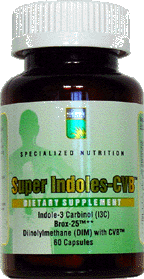Cruciferous vegetables such as broccoli sprouts, cauliflower, cabbage, and brussel sprouts contain a series of phytochemicals which react when the vegetable cell walls are broken by chewing, chopping, or juicing. Ic3 is just one of the many dietary indoles produced in this way. Icreasing consumption of these vegetables may be very beneficial to good health. DIM may promote healthy estrogen metabolism.
Epidemiological evidence overwhelmingly suggests that a diet high in fruits and vegetables is associated with a reduced risk of developing cancer of the breast, cervix, bladder, esophagus, lung, colon, oral cavity, stomach, pancreas and ovary. One particular study concludes that, “for
most cancer sites, persons with low fruit and vegetable intake (at least
the lower one-fourth of the population) experience about twice the risk
of cancer as compared to those with high intake, even after controlling
for potentially confounding factors.
Modern science has been able to identify some of the phytonutrients and
nutriceuticals found in fruits and vegetables that explain this predictable correlation between diet and disease prevention.
Research of particular interest in addressing the rising incidence of
breast cancer centers around the Crucifer (the Filseed family).
This botanical family is dominated by the genus Brassica which
includes the common cruciferous vegetables, including broccoli,
brussel sprouts, cauliflower, cabbage, bok choy, kale, rutabaga, turnips
and watercress.
These vegetables are the major source of glucosinolates
in the human diet. Glucosinolates are precursor structures until hydrolyzed
by the plant enzyme myrosinase, which is released from the vegetable cell
during the chewing process. Once hydrolyzed, glucosinolates form indoles,
isothiocynates, I3C, DIM and other related compounds.

